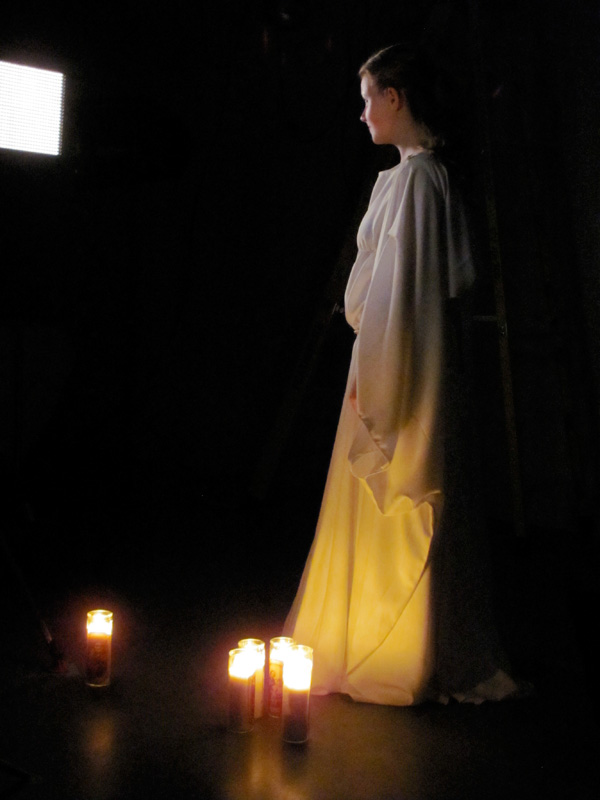Milford Haven
A video performance installation.
Written, directed & produced by
Louis Patrick Leroux
Assistant to the director & stage manager
Sara Rodriguez
Text translated by
Alexander Rock St-Laurent
Filmed and Edited by
Nika Khanjani
Second camera and sound by
Roch Michel Thibault
Sound design and editing by
Julian Stein
post-synch recording engineer
Drew Barnet
Costumes, props & art direction by
Danielle Laurin
Sewer:
Sonya Vallis
Makeup and hair:
Kyle Purves
Live video projection consultant:
Michal Seta
Imogen
Miriam Cummings
Iachimo
Christian Jadah
Upcoming Event
September 14-18, 2012
at Matralab
Milford Haven
Cymbeline Materials’ first project, a video performance installation.
More on the event

Description of installation
Video runs approximately 12 minutes.
Three video screens on which are projected simultaneous filmed performances of Imogen.
One mirror with video projections of Iachimo lurking about.
An object (ancient chastity belt on display over a miniature fenced-in lawn).
The audience into a haven-like clearing surrounded by the three rear-projected screens and mirror. In the center of the clearing is the object (chastity belt over fenced-in lawn).
Appropriate for gallery and performance spaces. Can be adjusted according to space.
Filmed in HD. Octophonic soundscape.
Story
The story is taken from Shakespeare’s Cymbeline and Boccaccio’s Decameron. Imogen, the daughter of the English king Cymbeline, and virtuous wife of Posthumous, has been the object of a rather macho debate. The husband, while bragging about his wife’s virtue, accepts a bet with sly Roman, Iachimo, who vows to seduce her and bring proof of his success. After having gained access to her chamber and spying on her, he returns with a detailed description of her as well as a trophy: her bracelet. Her husband, furious with a sense of cuckolded deceit, has her ordered dead by her footman, Pisanio. The monologue takes place after Pisanio has just left her in Milford Haven, under the false pretence of a heartfelt meeting with her husband. Rather than kill her, he abandons her there, leaving her trapped in her chastity belt.
The piece explores the timeless topic of women’s sexuality and men’s attempts to bind it, when they consider it their own, or to unleash and harness it, when it is withheld from them. Refusing to be mere property or game for sport, Imogen seeks agency and responsibility. She is alone, in Milford Haven, in those last moments of her life a daughter and wife of someone. Henceforth, she will be utterly alone. The story seems timely and of particular cultural relevance in light of recent awareness of honour killings.
Why installation and not theatrical performance?
For its larger than life sense of forced intimacy. For its precision. For its cold aesthetic qualities. For its unlimited iterations of a perfect performance looping in a state unalterable stasis. Imogen is stuck. This is a cruel snapshot of her moment of recognition. This is to be her fate. A live actor performing this piece would give a sense of finality, and of possible redemption (or at least escape, once the performance is over).


From Cymbeline to Milford Haven
The text was originally commissioned by Théâtre Urbi et Orbi and Théâtre d’Aujourd’hui in Montreal for a 1996 production of 38 adaptations of Shakespeare’s 38 plays by 38 Québec playwrights 38 and under. Louis Patrick Leroux was given Cymbeline to work from. The adaptation called for a single actor and could not run longer than 15 minutes. Live performances were held at Montreal’s Théâtre d’Aujourd’hui under the artistic guidance of Claude Poissant. The plays were also broadcast live across the country on Radio-Canada. The text was published by Dramaturges Éditeurs in 38, volume i in 1996. Nadine Desrochers played the part of Imogen. There is a tradition in Québec of post-colonial appropriations of Shakespeare as both a symbol of English cultural and economic imperialism and, as an author, as the symbol of universal genius with which to be measured.
Leroux avoided any explicit post-colonial reading of Cymbeline. Rather, he sought to engage with the author’s own reading of Boccacio’s more ancient tale. Not quite Shakespeare as our contemporary, but rather as one in a long line of rhapsodic storytellers.
The story, the characters, and the structuring of the play’s argument were all dramatic materials with which to engage. He chose to focus on a moment of disappointed expectation; the very moment Imogen realizes that her husband and her faithful servant have abandoned her. This terrible moment of recognition is drawn out, in a departure from Shakespeare’s script, and now constitutes the only truly real moment in Imogen’s now tragic life. Everything else has become anecdotal.
From French theatrical monologue to three-screened video installation in English
The text was translated into English, not Shakespeare’s, but a contemporary take on Leroux’s lyrical French. The English text then became a material the director worked with, straying away from the original solo performance.
The 1996 monologue was very much layered, skipping from one point of view to another, from the perspective of the seduction occurring to the realization—much later—that her resistance was turning against her. For the sake of the video performance, the initial four or five narratives were focused into three: Imogen narrating her tale, from the perspective of addressing a court now hostile to her; Imogen addressing Pisanio, the loyal servant, as she’s taking the full measure of her abandonment; and Imogen, very still, in bed, narrating to self, as Iachimo lurks around in her room. Consequently, each Imogen occupies a screen. They coexist and speak in turn, as if conscious of each other’s musings, as if answering each other’s desperate address to anyone willing to save them.
The filmed elements were shot on location in the ruins of St. Raphael’s church in Eastern Ontario and in studio in Hexagram-Concordia. The first public showing of the installation was developed, while in residence, at matralab in September 2012.

